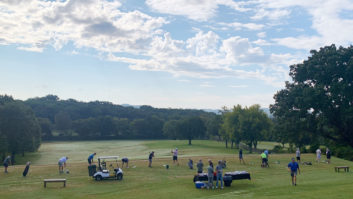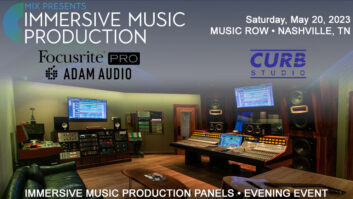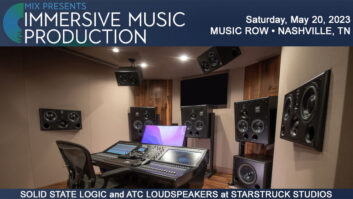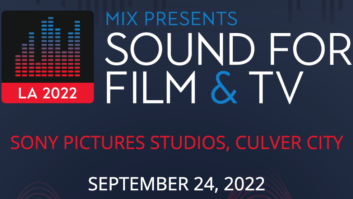
Nashville, TN—Nashville’s Berry Hill suburb began allowing residential and commercial businesses to coexist in the 1970s, setting the stage for the neighborhood to eventually rival Music Row as the city’s record production center, with houses and studios standing cheek by jowl. Two years ago, one of the first facilities to take advantage of that re-zoning, Scruggs Sound Studios, was purchased by multi-Platinum Scottish Canadian recording artist Johnny Reid, who recently relaunched it as Soultrain Sound Studios.
Constructed in the 1950s as a residential property, Randy Scruggs purchased what would become Scruggs Sound Studios and began building it out in 1979. Over the years it saw an impressive list of artists pass through its doors, including Johnny Cash, Willie Nelson, the Nitty Gritty Dirt Band, Allison Krauss, Toby Keith and Crosby, Stills and Nash. Suffering ill health in his later years, Scruggs put the studio on the market shortly before he passed away in April 2018.
“Johnny had a gorgeous house on a huge plot of land,” says mixer, engineer and producer Justin Cortelyou, who oversaw the technical refurbishments at Soultrain Sound. Reid had been planning to upgrade a barn behind his house into a full studio with Cortelyou’s help when a Tennessee Titans football player made him an offer for the property that he couldn’t refuse. Scruggs Sound offered an ideal alternative, although initial plans for a quick move-in morphed into an 18-month reconstruction project at the 3,000-square-foot facility, which is just a stone’s throw from Blackbird Studios, UMG’s new complex (formerly House of Blues Studios) and the regional offices of PMC and ADAM Audio.
“We said, let’s take down the wall coverings, maybe paint the front, get some gear in there and we’ll be good,” says Cortelyou. “You take down one wall and you find seven other problems. All the electrical had to be replaced. There’s all-new HVAC and the structure needed to be redone. We went down to the studs.”
The single tracking room with its multiple iso booths felt a little cramped. “The first thing we did was raise the ceiling by 18 inches or 2 feet. We took out the booths and put six windows in.”
Scruggs’ tape vault and an office space, no longer needed, have been reconfigured into a machine room and a B room, occupied by producer and engineer Tawgs Salter, with its own entrance. The B room has tielines to the piano booth and vocal booth, and it can act as an additional tracking space for the main control room.

Cortelyou left his position at producer Bob Ezrin’s nearby studio—where he worked with the likes of Paul McCartney, Deep Purple, Alice Cooper, Joe Perry, Johnny Depp, Phish, Kesha and KISS—to join Reid in the venture. Given carte blanche to outfit the control room to meet his needs, Cortelyou drew on his time working with the late Mike Shipley at the engineer and producer’s Animal House studio in Los Angeles during the mid-aughts.
Shipley favored SSL 4000 E Series consoles and Waves’ E-Channel Strip plug-in, “so my first instinct was to look for an E,” Cortelyou says. Reid found a suitable desk on Craigslist, with 32 mono and four stereo channels, at local producer Keith Gattis’ private studio. “It was in immaculate condition and had just been re-capped, and it’s got the Tangerine computer,” says Cortelyou.
The studio came with a lot of great pieces, he continues, including several dbx 160 compressors, Sontec EQs, an EMT 250 reverb and an AMS RMX16 reverb, as well as numerous high-end vintage mics and an Otari MTR-90 tape machine in need of a little TLC. Out went the Radar digital recorders, in came a Pro Tools rig, a Burl Mothership converter system and a Mytek Private Q setup. The control room’s vintage Altec Big Reds have been moved into the live room and replaced by PMC MB3 main monitors. Reid also brought in a few items, says Cortelyou, including a Shadow Hills Mastering Compressor.
Spending all his free time on Reverb.com, Cortelyou says, “The first piece we bought was the RCA BA-6A [tube compressor]. That was what Mike used on vocals when I was working with him. It just makes everything sound bigger and better. That’s my favorite piece.”

The outboard collection grew to include pairs of Neve 1081, BAE 1073 and Shep 1073, as well as eight channels of API 3124 mic preamps. They were soon joined by vintage Neve 2254 and 33609 compressors.
Newer gear includes a Coil Audio CA-286 multichannel mic preamp, which he uses for mixing and tracking. “They put a variable negative feedback on there, so you can close it down or open it up, depending on your source.”
Having previously used UnderTone Audio’s MPDI-4 mic pre on a session with drummer Kenny Aronoff, Cortelyou bought 16 channels for Soultrain. “We can run all the drums through it,” he says.
“I don’t run anything through the console mic pre’s because I don’t have to. When you’re tracking on an SSL, you can do a lot of monitor-side EQ and compression and make it fun for the artist. You don’t have to commit to that on the way in, so it’s a great working environment.”
But they still needed a couple of “wow” pieces, he says. “I said, what about UTA’s UnFairchild compressor? And then we found a stereo tube EMT 140 [plate reverb] from the Record Plant in New York.”
Since Soultrain Sound is Reid’s private production facility, Reid approached the redesign as an artist, creating a comfortable environment with top-notch materials and amenities, says Cortelyou. Nashville-based designer Lori Paranjape oversaw the interior and exterior finishes. “The concept was to make it like a boutique hotel.”
Reid even consulted with his touring lighting designer and installed a DMX system, controlled from an iPad, that changes color. “Because all the walls and baffles are white, they take on whatever color you make it. I was like, whatever—until I saw it. It sounds cool and silly, but it makes a big difference.”
In fact, the studio is such a creative environment that it’s easy to lose track of time, says Cortelyou, but in a good way. “I’ll look at my watch and it’s six o’clock already. It’s just so comfortable. And when you let down your guard, you get into that creative mode a little bit quicker.”
Soultrain Sound Studios • www.soultrainstudios.com







